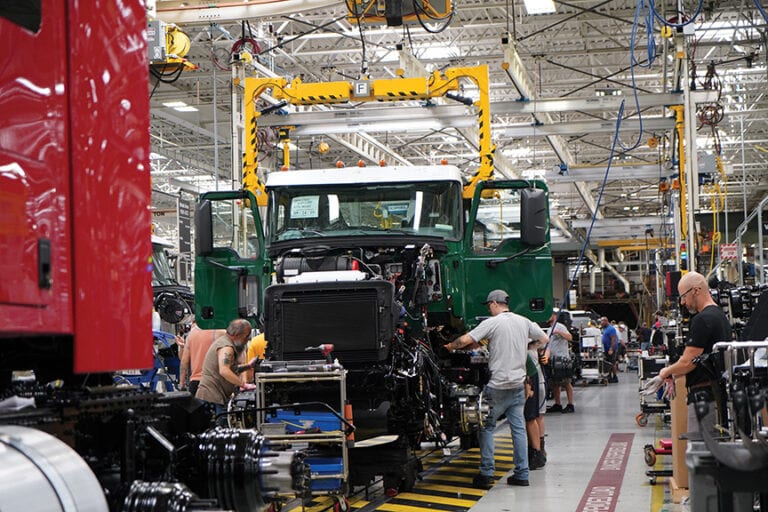If the year 2020 taught us anything about business, it’s that predictions are often worth the real estate value of the cyberspace they occupy. Regardless, plans must be made, and the best we can do is review the evidence, give the analysts a listen, and forge ahead, hoping for some sort of normalcy by year’s end.
Planning for motor carriers basically boils down to three points — trucks, good rates, and drivers.
As for trucks, the question is whether carriers will be able to purchase enough new ones to meet the demand this year.
Sales of new Class 8 trucks have remained high and the backlog of orders is growing quickly. After a disastrous second quarter, sales rebounded, resulting in 2020 totals that were within a few hundred trucks of 2016 and 2017 sales. In January, according to an ACT Research preliminary report, another 42,200 trucks were ordered for the North American market. That’s a 146% improvement from January 2020 order numbers.
“At this introductory pass at 2021 commercial vehicle data, the consumer economy lacks the stimulus-fueled robustness that characterized spending into early Q4,” said ACT President and Senior Analyst Kenny Vieth. “Even as consumers look less hearty — at least in the short-term — manufacturing sector indicators show that the industrial economy is shaking off the dust of two years of tepid activity.”
The fourth consecutive month of orders exceeding 40,000 is stressing supply chains, said FTR Transportation Intelligence Vice President of Commercial Vehicles Don Ake. Fleets are placing orders now that may not be delivered until the end of the year, he shared.
“Currently there are shortages of raw materials and component parts, which will result in supply being unable to meet the demand of Class 8 trucks in the short term,” said Ake. That includes semiconductors critical to manufacturing. Daimler AG warned that shortages could impact production in the first quarter of 2021.
Vieth summed up the supply situation this way: The supply chain’s ability to respond to demand will be the key determinant of Class 8 production in 2021.
“As we start 2021, the high points for commercial vehicle demand include strength in key freight generating economic sectors, carrier profitability that is expected to rise to record levels this year, strong orders and rapidly-filling backlogs,” said Vieth. “While demand is strong, supply chain impediments are accumulating, from steel production constraints created by global economic reengagement during a pandemic, to silicon chip shortages, and, in late January, the Mexican government ordering oxygen producers to give medical demand precedence over industrial supplies.”
As for available freight and good rates, February started with both positive and disturbing news.
FTR’s Shipping Conditions Index for November remained in negative territory at -9.04 although improved from the October reading of -11.6. The index is issued two months after the data is gathered. The improvement was primarily because of some stabilization in capacity utilization, but utilization and rates remained very elevated, a negative for shippers.
On the good side, FTR’s Chief Intelligence Officer Jonathan Starks said, no matter which mode or region, freight rates continued to stay elevated as we finished off 2020 and moved into the new year. “Demand may be leveling off, but we are still seeing truck volumes in the spot market that are double the five-year average.”
On another positive note, December freight numbers were higher in most available tonnage reports. ACT’s For-Hire Tonnage Index showed an eighth consecutive month of growth. Cass Information Systems, which reports shipment activity across multiple modes of transportation, reported that shipment rates for December not only grew from November but topped December 2019 numbers as well.
Freight rates declined slightly on the spot market but remain high, while contract rates are still growing as carriers work with customers to adjust to tightened capacity.
FTR’s rate index, issued February 8, actually bucked seasonal trends to set a new post-pandemic high with seasonally adjusted freight activity increased nearly 6% from the prior week. Volume is about 17% higher than the previous pandemic high recorded during the week ending January 8.
The looming issue for trucking is the driver shortage. For various reasons, more drivers are leaving the industry, while the commercial driver’s license (CDL) schools that supply new drivers are running at less-than-full capacity — if they are even open. Numerous states have closed at least some testing facilities, and several suspended testing for new CDLs at all for various lengths of time.
On the plus side, the number of drivers leaving the industry or bouncing between carriers appears to have slowed.
The third-quarter turnover rate at large truckload carriers fell 11 percentage points to 87%, marking its lowest point since the first quarter of 2017, when it was 74%. At the same time, the churn rate at smaller truckload carriers — fleets with less than $30 million in annual revenue — was flat, and less-than-truckload carriers experienced a single-digit decrease in turnover.
The decline at the large truckload carriers comes after two quarterly increases last year that saw the churn rate climb to 98%.
Additionally, hikes in driver pay and softer freight volumes were factors behind the decline, according to American Trucking Association’s Chief Economist Bob Costello.
Another potential issue is the price of fuel. According to the U.S. Energy Information Administration, the national average price for a gallon of ultra-low sulfur diesel has risen by 12.2% since last October, increasing in each month.
Despite the risks, analysts have been positive about the prospects for trucking this year. In one interview, ACT’s Vieth disclosed, “I’m predicting record trucking industry profits in 2021.”
Last month, FTR’s trucking expert Avery Vise said in an interview, “The next year, by and large, looks to be pretty good, but there are some risks.”
Service providers are reopening and lives are beginning to return to something like normal, but recovery depends on how quickly all of that happens. If congressional stimulus talks fail or if the vaccination program takes longer than anticipated, the economy could stall in response. But if things go as expected, freight levels should remain favorable. Capacity should remain tight enough to maintain freight rates, while driver pay hikes take up a percentage of the additional revenue.
All in all, 2021 looks to be a more normal year for trucking. Whatever that “normal” may be.
Cliff Abbott is an experienced commercial vehicle driver and owner-operator who still holds a CDL in his home state of Alabama. In nearly 40 years in trucking, he’s been an instructor and trainer and has managed safety and recruiting operations for several carriers. Having never lost his love of the road, Cliff has written a book and hundreds of songs and has been writing for The Trucker for more than a decade.















